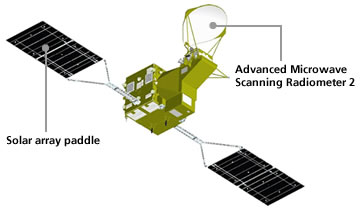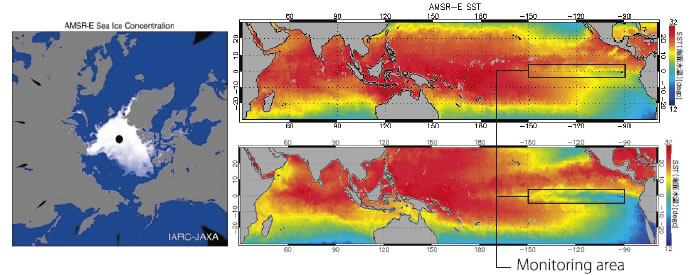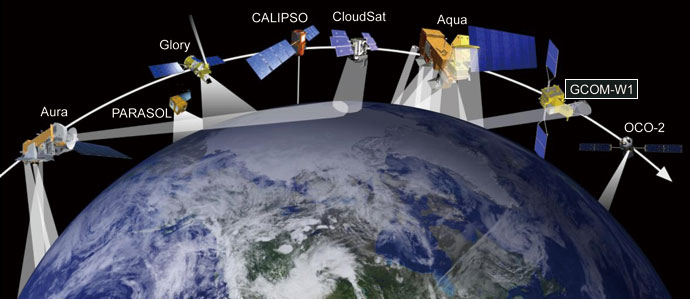GCOM-W1: Global Change Observation Mission 1st - Water "SHIZUKU"
 GCOM (Global Change Observation Mission) is a project for the global and long-term observation of the Earth environment. GCOM is expected to play an important role in monitoring global water circulation and climate change. It will be a kind of health checkup of the Earth from space.
GCOM (Global Change Observation Mission) is a project for the global and long-term observation of the Earth environment. GCOM is expected to play an important role in monitoring global water circulation and climate change. It will be a kind of health checkup of the Earth from space.GCOM consists of two satellite series, GCOM-W and GCOM-C. GCOM-W carries the AMSR2 (Advanced Microwave Scanning Radiometer 2), an instrument to observe water-related targets such as precipitation, water vapor, sea surface wind speed, sea surface temperature, soil moisture, and snow depth. GCOM-C carries the SGLI (Second Generation Global Imager), an instrument for surface and atmospheric measurements of phenomena involved in the carbon cycle and radiation budget, such as clouds, aerosol, ocean color, vegetation, and snow and ice.
Global and long-term observation (10-15 years) by GCOM will help scientists understand the mechanisms of water circulation and climate change.
"SHIZUKU" (GCOM-W1) is the first satellite of the GCOM-W series.
Health Checkup of the Earth from Space
The Advanced Microwave Scanning Radiometer 2 (AMSR2) on-board "SHIZUKU" (GCOM-W1) is a remote sensing instrument for measuring weak microwave emission from the surface and the atmosphere of the Earth. From 700km above the Earth, the AMSR2 will provide us with highly accurate measurements of the intensity of microwave emission.The antenna of the AMSR2 rotates once per 1.5 seconds and obtains data over a 1450km swath. This conical scan mechanism enables the AMSR2 to acquire a set of daytime and nighttime data with more than 99% coverage of the Earth every 2 days.
The AMSR2 is a successor to the AMSR on Japanese ADEOS-II and the AMSR-E on Aqua, a NASA satellite. The achievements of these predecessor systems in monitoring phenomena such as El Nino, La Nina, and sea ice in polar regions have set a high value to Japanese microwave instruments. They have also contributed to practical applications, such as numerical weather prediction by the Japan Meteorological Agency (JMA) and sea state reports for fishermen by the Japan Fisheries Information Service Center (JAFIC).
Examples observed by AMSR-E on Aqua

Left : Sea ice in Arctic Ocean , Right : El Nino(Upper) & La Nina(Lower)

Left : Sea ice in Arctic Ocean , Right : El Nino(Upper) & La Nina(Lower)
"SHIZUKU" (GCOM-W1) will join the A-Train constellation led by NASA. The participation of GCOM-W1 into the A-Train constellation will enable the simultaneous observation with instruments mounted on other satellites and enhance the scientific research using AMSR2 data.
The conceptual diagram of the A-Train


Major Characteristics
| Design Life | 5years |
|---|---|
| Power/Mass | 4050W (EOL) /1900kg |
| Orbiter | Sun-Synchronous Subrecurrent/ Recurrent |
| Altitude/Inclination | 700km/ (98.2deg) |
| Local sun time at ascending node | 13:30±15min: the same as AMSR-E |
| AMSR2 Characteristics | 7GHz - 89GHz: 6bands 5 - 50km Resolution 1450km Swath Width |
